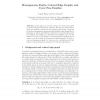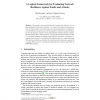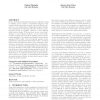184 search results - page 6 / 37 » Communication in Networks with Random Dependent Faults |
ICITS
2011
12 years 10 months ago
2011
In this paper, we use the concept of colored edge graphs to model homogeneous faults in networks. We then use this model to study the minimum connectivity (and design) requirements...
ASIAN
2007
Springer
14 years 1 months ago
2007
Springer
Abstract. We present a logic-based framework to evaluate the resilience of computer networks in the face of incidents, i.e., attacks from malicious intruders as well as random faul...
ETFA
2005
IEEE
14 years 1 months ago
2005
IEEE
Industrial control systems architectures have been evolving to the decentralization of control tasks. This evolution associated with the time-critical nature of these tasks, incre...
NOMS
2000
IEEE
13 years 11 months ago
2000
IEEE
Recently mobile agent technology has been recognised as a potential tool for realising distributed network fault management. The autonomy and mobility of such agents can help ensu...
SIGOPS
2011
13 years 2 months ago
2011
Secure, fault-tolerant distributed systems are difficult to build, to validate, and to operate. Conservative design for such systems dictates that their security and fault toleran...



